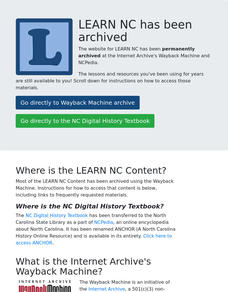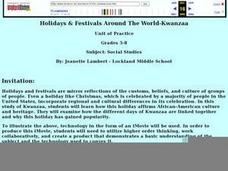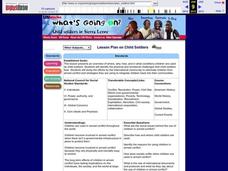Curated OER
Our Little Town
Students take local walking tours and incorporate technology by using a digital camera to take photographs. They use the computer to display these photographs using different software programs such as SimTown, to create a visual map of...
Curated OER
Caching in Pine's Treasures
Students compile image information about the Junior High School using a digital camera. They survey the area making observations and recording them with the help of portable technology and transferring the data to a spreadsheet and...
Curated OER
Cultural Impact of Jim Crow Laws and the Civil Rights Movement
Students examine the Jim Crow laws and how they impacted the lives of both African Americans and white Americans. They discuss the Civil Rights Movement and how their lives may have been different had it not occurred.
Groups...
Curated OER
Egypt: Old Stuff a New Way
Tenth graders explore ancient Egypt. In this visual arts instructional activity, 10th graders create a life-size ancient Egyptian. Students conduct research in order to build an historically accurate representation of the Egyptian.
Curated OER
How to Teach Geography with KidPix 1
Students create a compass rose. In this geography lesson, students create a compass rose using the computer program KidPix 1.
Curated OER
The Candidate: Issues and Strategies
Students discuss the candidates image and how an image impacts the voters. In this candidates image lesson plan, students read and discuss different factors that make up the candidates image.
Curated OER
Chapter 9 - Big Business v. Labor
For this 20th century U.S. history worksheet, students read assigned textbook pages regarding the industrialization and labor unions. Students then respond to 50 short answer questions.
Curated OER
Chapter 23 – The Civil Rights Movement
In this U.S. history worksheet, students read assigned textbook pages on the Civil Rights Movement and respond to 48 short answer questions.
Curated OER
Separate is Not Equal
Students use political cartoons and editorials to study Brown v. Board of Education. In this Brown v. Board of Education lesson, students read the background information on eight cartoons and editorials for a study on Brown v....
Curated OER
European Union Overview II
In this European Union worksheet, students respond to 6 matching and 15 fill in the blank questions that provide an overview of the European Union governing body.
Curated OER
EU Institutions
In this European Union practice worksheet, students respond to 8 short answer questions about the European Union institutions.
Curated OER
The Bill of Rights Today
Students discuss the Bill of Rights and how the Bill of Rights relates to everyday life. In this Bill of Rights lesson plan, students identify and explain each amendment.
Curated OER
American Indian Tribes
Second graders explore two Indian tribes. They explore how tribes lived using natural resources. They compare Eastern Woodland and Plains Indians.
Curated OER
Exploring The Everglades
Fifth graders apply basic Internet navigation and computer skills to complete a scavenger hunt about the Everglades, after reading the book, Everglades, by Jean Craighead George.
Curated OER
Holidays & Festivals Around The World-Kwanzaa
Students use technology to conduct research. They use technology to convey principles and information. They demonstrate proficiency in the use of computer based technology.
Curated OER
Diversity of Families
Students discuss the word "family" and examine the various types of families, focusing on those of students in the classroom. They create a "School Family Tree" that builds on the diversity of students in the classroom.
Curated OER
Exploring the Objectives of the European Union
Students identify the members of the EU and brainstorm on how these countries would benefit by having an alliance. In groups, they examine the main objectives of the EU and present to the class.
Curated OER
What is Culture?
Students explore the concept of culture. They discuss the Washoe culture, create a word web, develop a family tree of their own family for a class book, and complete a writing assignment.
Curated OER
Local and Global Sustainability Unit
Students examine the characteristics that define a sustainable community at the local and global level. They create and prioritize a list of traits, read and discuss a magazine article, and create a poster.
Curated OER
American Deaf Culture: Deaf Art
Students examine the culture and art of the Deaf Community. They discover the history of the Deaf Community using art and their values. They compare and contrast different pieces of art.
Curated OER
Hachimaki/Shibori
Sixth graders investigate a Japanese dyeing method, Arashi shibori, its history and its process. They are introduced to hachimaki, a Japanese headband, and make their own to wear.
Curated OER
Surfin' the U.S.A. with Road Rabbit
Students take virtual field trips to places in the U.S.A. in conjunction with the stops made by the class mascot, Road Rabbit. As Road Rabbit
travels to his destination(s) via snail mail, so do the students via the Internet.
Curated OER
The Role of the Museum
Learners identify the role of the museum as a cultural resource in the community. They use primary and secondary sources to evaluate institutional, and media influences on people and society in both historical and contemporary settings.























